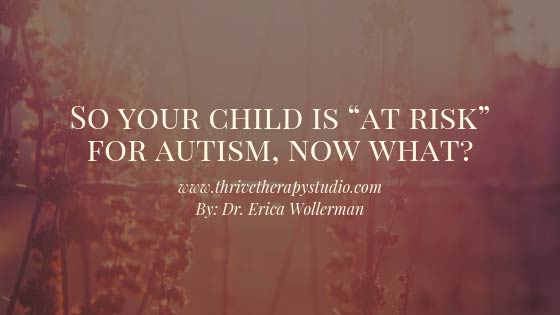Some readers might be wondering what autism even is so I thought it might help to share a bit about it before continuing with the blog. In layperson’s terms, autism is term that describes a broad range of conditions that typically involve challenges in social relationships, verbal skills, nonverbal communication, general development, and can include repetitive behaviors or approaching the world in a more rigid, structured way. Because the term “autism” encompasses a wide spectrum of individuals who often experience the world in many different ways, it is difficult to generalize what an autism diagnosis will mean for your family or child. It is best to seek understanding for how your child may or may not experience the world, rather than to project ideas of what this might mean for them onto them. Also keep in mind that many common portrayals of individuals with autism in our media (example of Rain Man) are entirely inaccurate and do not describe everyone.
Since one of my specialties is working with parents of kids with autism and working with individuals on the autism spectrum in general, a question I get asked a lot is about what to do when your child is either screened as being at risk for having autism or newly diagnosed with autism. Particularly because young children are often getting screened for autism starting at their well child visits with their pediatricians around a year of age or younger, this has become much more common for parents to wonder about and experience.
In my experience, this can be such an overwhelming process for parents and one that unfortunately, not every pediatrician is skilled at handling well with them. Often, parents are given a long list of resources without much direction as to what would be most helpful for their child or they are steered towards Applied Behavioral Analysis (ABA) immediately. While ABA can be helpful for some children, it is becoming much more commonly referenced as a therapy to treat almost any childhood challenge. I find this a bit alarming because ABA therapy is very behavioral in nature and at times can miss the more emotional component of what is going on for children.
So, what do I recommend to parents with either a newly diagnosed child on the spectrum or a newly screened “at risk” toddler?
Step One: Take a deep breath.
This sounds silly but I find that parents in this situation are so overwhelmed and overcome with a feeling of urgency to get your child into the “right” treatment or intervention that is going to “fix” them. The thing is, it is okay and preferable to take some time with this experience. Your child is not different today than they were yesterday and while early intervention is very helpful, it is okay if you set it up next week or next month, rather than right this second. It is okay to make sure you are wrapping your head around what is happening first so that you can be a calm place to set up the services you feel comfortable with. In other words, take a deep breath and let yourself sit with this information before you do anything else. A calm, peaceful parent is going to be the most helpful as you go through the next parts of this process.
I’d also like to note that there are a lot of myths out there about what it means to have autism and that the reality is not what you may see on TV, movies, or the internet. It is a BIG spectrum with a lot of variability so just because your child might fall somewhere on it, does not mean they will be a certain way or not be a certain way. For example, parents tend to worry that their child will not show them affection if they have autism and this is just not the case for all kids. Some kids are affectionate, some are not and this applies similarly to people on the spectrum too.
While having a child with autism can be challenging at times, it is also pretty amazing at times – just like parenting any child. I am of the belief that we all have our struggles, and our children will too, and it is all about figuring out what our children need to thrive. Some of my favorite clients and people have autism and I truly love being able to know them and the way they experience the world. I could go on and on but my point here is simply, try not to panic or overreact to this news.
Step Two: Do a little research.
By this, I mean that it would be helpful to consider what your child is experiencing and if you fully agree with their diagnosis or at risk status. Have you been having concerns yourself perhaps that their development is not where you think it should be or matching other kids you know or see? When you read more about children with autism, does it match your experience? Do you feel you might want a second opinion? Maybe read a few books or blogs from other parents or experts in the field to help you gage what you are seeing and feeling. Keep in mind that some children are going to get a positive screen and then not end up meeting the criteria for being on the spectrum when they are older. I always say that this is why I am so conservative in diagnosing children and teens because sometimes their symptoms are more developmental than pathological, though they may at times be problematic.
Step Three: Seek Consultation
I would also encourage you to seek consultation with a therapist or psychologist who specializes in working with children on the spectrum or even to seek out a more formal full developmental assessment. Ideally, this person can help you chart a course of treatment individualized to your family and child’s situation. Often, parents are given so many ideas of what to do (Speech, OT, ABA, individual therapy, group therapy, etc.) that it can be overwhelming. Ideally, you can find someone who can help you determine what your child would benefit most from and start with that method of therapy. Therapists, psychologists, speech, and OT providers can be helpful to consult with to help you determine the best path forward.
If you feel your child’s diagnosis is accurate, this is where you want to start collecting treatment options to see what would be a good fit for your family. It might help to join some Facebook groups with other parents in the same situation so that you can check in with what other parents are doing and what their experiences have been with different therapies and providers. I have found that treatment options really vary depending on your child’s presentation and needs so remember that none of this is one size fits all! A great resource in San Diego can be San Diego Regional Center also so this might be a good time to reach out to them.
I hope these ideas are helpful to you! If you have questions or are a parent of a newly diagnosed child with autism or even an “at risk” child, feel free to reach out to us to see if we can support you at our office. We love working with parents in parent consultation sessions or even individual therapy to help support you throughout this process. Raising a child who is developing differently can be very challenging at times and we are happy to help however we can!
Reach out to start
your healing journey


